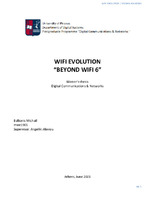| dc.contributor.advisor | Αλεξίου, Αγγελική | |
| dc.contributor.advisor | Alexiou, Angeliki | |
| dc.contributor.author | Μπαλκώνης, Μιχαήλ | |
| dc.contributor.author | Balkonis, Michail | |
| dc.date.accessioned | 2021-07-15T07:43:25Z | |
| dc.date.available | 2021-07-15T07:43:25Z | |
| dc.date.issued | 2021-06 | |
| dc.identifier.uri | https://dione.lib.unipi.gr/xmlui/handle/unipi/13562 | |
| dc.identifier.uri | http://dx.doi.org/10.26267/unipi_dione/985 | |
| dc.description.abstract | Αντικείμενο της παρούσας Διπλωματικής Εργασίας είναι η εξέλιξη του προτύπου WLAN 802.11 γνωστό και ως WIFI. Η παρούσα μεταπτυχιακή εργασία έχει ως σκοπό την αναφορά και ανάλυση του προτύπου 802.11be καθώς και των χαρακτηριστικών του WIFI 6 ή 802.11ax πάνω στα οποία θα βασιστεί η ανάπτυξη και η εξέλιξη του WIFI 7.
Θα αναλυθούν χαρακτηριστικά του WIFI 6 καθώς τα στάνταρντ οι στόχοι και μελλοντικές εξελίξεις που θα επιφέρει το WIFI 7 (802.11be) ή αλλιώς Extremely High Throughput στην κοινωνία μας.
Στο 1ο κεφάλαιο γίνεται μια γενική εισαγωγή στα ασύρματα δίκτυα. Εξηγούμε τι είναι τα ασύρματα δίκτυα, που μας χρειάζονται, καθώς πραγματοποιείται και μια ιστορική αναδρομή. Συνεχίζοντας επισημαίνεται η βασική αρχιτεκτονική του WLAN 802.11 με τα στοιχεία που χρησιμοποιούνται στα ασύρματα δίκτυα. Πραγματοποιείται μια αναφορά στις προδιάγραφες των στάνταρ του 802.11. Καθώς τέλος αναλύεται τόσο το Physical όσο και το MAC στρώμα.
Στο 2ο κεφάλαιο γίνεται μια εκτενέστερη επισκόπηση στο πρότυπο 802.11ax, αναλύονται τα νέα χαρακτηριστικά καθώς και οι σχεδιαστικοί στόχοι. Στη συνέχεια πραγματοποιείται μια επισκόπηση φυσικών βελτιώσεων του προτύπου 802.11ax. Ολοκληρώνοντας το κεφάλαιο αναφέρονται οι περιπτώσεις χρήσης καθώς και τα πλεονεκτήματα ,μειονεκτήματα του προτύπου 802.11ax.
Το 3ο κεφάλαιο αναφέρεται στο μελλοντικό WI-Fi και συγκεκριμένα η επέκταση του Wi-Fi 6 στη μπάντα των 6GΗz με την σημαντικότητα της και της αλλαγές τις οποίες θα επιφέρει. Αναφέρονται τα πλεονεκτήματα της αναβάθμισης αυτής καθώςς και τις προκλήσεις που θα επιφέρει η εξέλιξη αυτή.
Στο 4ο κεφάλαιο κάνουμε αναφορά στο μελλοντικό WIFI 7 και συγκεκριμένα με την ονομασία του Extremely High Throughput , IEEE 802.11be. Στο κεφάλαιο αυτό θα μελετηθεί το χρονοδιάγραμμα ανάπτυξης του όπως αυτό ορίζεται από την WIFI κοινότητα καθώς και τις ημερομηνίες κυκλοφορίας των χαρακτηριστικών του.
Θα αναλυθούν τα χαρακτηριστικά που επρόκειτο να εισαχθούν στη νέα τεχνολογία τόσο στο φυσικό στρώμα όσο και στο στρώμα της MAC.
Στη Συνέχεια στο κεφάλαιο 5 θα γίνει μια εκτενέστερη αναφορά σε ένα βασικό χαρακτηριστικό που θα έχει βασική θέση στις μελλοντικές εξελίξεις , αυτό είναι Time Sensitive Network (TSN) του 802.11be, καθώς και τις βελτιώσεις τις οποίες θα επιφέρει. Επιπροσθέτως αναλύονται οι τομείς και τις περιπτώσεις χρήσης στη κοινωνία μας το χαρακτηριστικό του TSN. Κλείνοντας θα παρουσιαστούν καποια Simulations και τα αποτελέσματα αυτών. | el |
| dc.format.extent | 146 | el |
| dc.language.iso | en | el |
| dc.publisher | Πανεπιστήμιο Πειραιώς | el |
| dc.rights | Αναφορά Δημιουργού-Μη Εμπορική Χρήση-Όχι Παράγωγα Έργα 3.0 Ελλάδα | * |
| dc.rights.uri | http://creativecommons.org/licenses/by-nc-nd/3.0/gr/ | * |
| dc.title | WIFI evolution “beyond WIFI 6” | el |
| dc.type | Master Thesis | el |
| dc.contributor.department | Σχολή Τεχνολογιών Πληροφορικής και Επικοινωνιών. Τμήμα Ψηφιακών Συστημάτων | el |
| dc.description.abstractEN | The subject of this Thesis is the evolution of the WLAN 802.11 standard also known as WIFI. The aim of this dissertation is to report and analyze the 802.11be standard as well as the features of WIFI 6 or 802.11ax on which the development and evolution of WIFI 7 will be based.
Features of WIFI 6 will be analyzed as well as the standards, goals and future developments that WIFI 7 (802.11be) or Extremely High Throughput will bring to our society.
Chapter 1 provides a general introduction to wireless networks. We explain what wireless networks are, which we need, as well as a historical background. Continuing, the basic architecture of WLAN 802.11 is highlighted with the elements used in wireless networks. A reference is made to the specifications of the 802.11 standards. Finally, both the Physical and the MAC layer are analyzed. Chapter 2 provides a more comprehensive overview of the 802.11ax standard, analyzing the new features as well as the design objectives. An overview of the physical improvements of the 802.11ax standard is then performed. At the end of the chapter, the cases of use are mentioned as well as the advantages, disadvantages of the 802.11ax standard. Chapter 3 refers to the future Wi-Fi and specifically the expansion of Wi-Fi 6 in the 6GHz band with its importance and the changes it will bring. The advantages of this upgrade as well as the challenges that this development will bring are mentioned. In Chapter 4 we refer to the future WIFI 7 and specifically to the name of Extremely High Throughput, IEEE 802.11be. This chapter will study its development schedule as defined by the WIFI community as well as the release dates of its features.
The characteristics that were to be introduced in the new technology in both the physical layer and the MAC layer will be analyzed. In the following Chapter 5 a more detailed reference will be made to a key feature that will play a key role in future developments, namely the 802.11be Time Sensitive Network (TSN), as well as the improvements it will bring. In addition, the sectors and cases of use in our society of the TSN feature are analyzed. In closing, some Simulations and their results will be presented. | el |
| dc.contributor.master | Ψηφιακές Επικοινωνίες και Δίκτυα | el |
| dc.subject.keyword | Wi-Fi | el |
| dc.subject.keyword | 802.11be | el |
| dc.date.defense | 2021-06-30 | |



